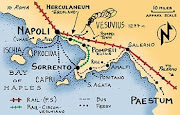 Paestum is one of the best collections of Greek temples anywhere, and certainly the most accessible to western Europe. Located in the Sele plain (Cilento National Park), Paestum was founded by the Dorics in 650 B.C. under the name of Poseidonia; conquered by the Lucanians who called her Paistos and then, in 273 a.C. by the Romans who gave it the name of Paestum. The walls date back to the IVth century with Roman and Lucan parts and are strengthened by towers often as thick as 7 meters. Inside the town there are the Temple oh Hera, dating back to 550 B.C., with nine columns on the short sides and eighteen on the long ones and remains of the decoration of the architrave, and the Temple of Nettuno, built in 450 B.C., imposing and harmonious, formed by a base with three steps on which stand six columns on the short sides and fourteen on the long ones. The columns are all nine meters high and are united, on top, by an architrave supporting a sloping roof ending both on the front and in the back with two pediments; the Temple of Cerere of 500 B.C., with six columns on the short sides and thirteen on the long ones. In the inside part there can be still seen the remains of such places as the Curia, the thermae, the Italic temple, the comitium, the aerarium etc.. In the nearby museums there are precious materials coming from the town and from the neighbourood among which ceramics and sculptures, fictile little statues, bronzes and the slabs of the famous "Tomba del Tuffatore" dating back to 490 B.C., the only example of wall paintings of Magna Graecia. Next to the museums stands the early Romanic basilica of Annunziata, noteble sacred building with nave and two aisles.
Paestum is one of the best collections of Greek temples anywhere, and certainly the most accessible to western Europe. Located in the Sele plain (Cilento National Park), Paestum was founded by the Dorics in 650 B.C. under the name of Poseidonia; conquered by the Lucanians who called her Paistos and then, in 273 a.C. by the Romans who gave it the name of Paestum. The walls date back to the IVth century with Roman and Lucan parts and are strengthened by towers often as thick as 7 meters. Inside the town there are the Temple oh Hera, dating back to 550 B.C., with nine columns on the short sides and eighteen on the long ones and remains of the decoration of the architrave, and the Temple of Nettuno, built in 450 B.C., imposing and harmonious, formed by a base with three steps on which stand six columns on the short sides and fourteen on the long ones. The columns are all nine meters high and are united, on top, by an architrave supporting a sloping roof ending both on the front and in the back with two pediments; the Temple of Cerere of 500 B.C., with six columns on the short sides and thirteen on the long ones. In the inside part there can be still seen the remains of such places as the Curia, the thermae, the Italic temple, the comitium, the aerarium etc.. In the nearby museums there are precious materials coming from the town and from the neighbourood among which ceramics and sculptures, fictile little statues, bronzes and the slabs of the famous "Tomba del Tuffatore" dating back to 490 B.C., the only example of wall paintings of Magna Graecia. Next to the museums stands the early Romanic basilica of Annunziata, noteble sacred building with nave and two aisles.The National Archaeological Museum of Paestum
The Museum of Paestum is certainly between the most important Italian archaeological museums. In it is guarded one of the most valuable collections of archaic sculptures than coming from southern Italy (cycle of metope of the Heraion of Foce Sele VI sec. B. C.) and of funeral paintings referable to the lucano period (IV sec. B.C.) that they are today an unicum, like it is, for the Classical age, the so-called "Tomba del Tuffatore" (Tomb of the Diver), exceptional example, splendidly preserved, of funeral painting of Greek tradition.The Archaeological Park of Paestum
The Archaeological Park of Paestum is characterized from the ruins of the city Sanctuary with the monumental testimonies of the three great Temples, exceptionally preserved, dedicated to the goddess Hera (the so-called Basilica and Temple of Neptune) and to Athena (so-called Temple of Cerere), datable between the half of VI and half of V sec. B. C. . The testimonies of the Greek city (Agorà, so-called sacello ipogeico) and Roman, with the amphitheatre, the monuments of the Foro and the insulaes of residence are moreover visitable.
Restaurants in Paestum
Da Nonna Sceppa Via Laura, 53Telephone: 0828/851064
Il GranaioVia Porta Marina 86Telephone: 0828721014
Nettuno Archaeological zoneTelephone: 0828/811028
L’OasiVia Magna Grecia 72Telephone: 0828/811935
Il Cantinone
Via Magna Grecia 51Telephone: 0828/723377
Le Trabe Via Capodifiume 1Telephone: 0828/724165
Driving distances and approximate driving times
Salerno: 37 km / 23 miles / 45 min.
Pompeii: 74 km / 46 miles / 80 min.
Sorrento: 100 km / 62 miles / 103 min.
Amalfi: 61 km / 38 miles / 90 min.
Naples: 99 km / 61 miles / 100 min.
Acciaroli: 44 km / 27 miles / 54 min
Santa Maria di Castellabate: 20 km / 13 miles / 30 min.
San Marco di Castellabate: 22 km / 15 miles / 35 min.
Perdifumo: 29 km / 19 miles / 45 min.
Agnone: 37 km / 23 miles / 57 min.
Ascea Marina: 50 km / 31 miles / 70 min.
S.Mango Cilento: 32 km / 20 miles / 50 min.
Marina di Camerota: 44 km / 27 miles / 54 minutes

Nessun commento:
Posta un commento